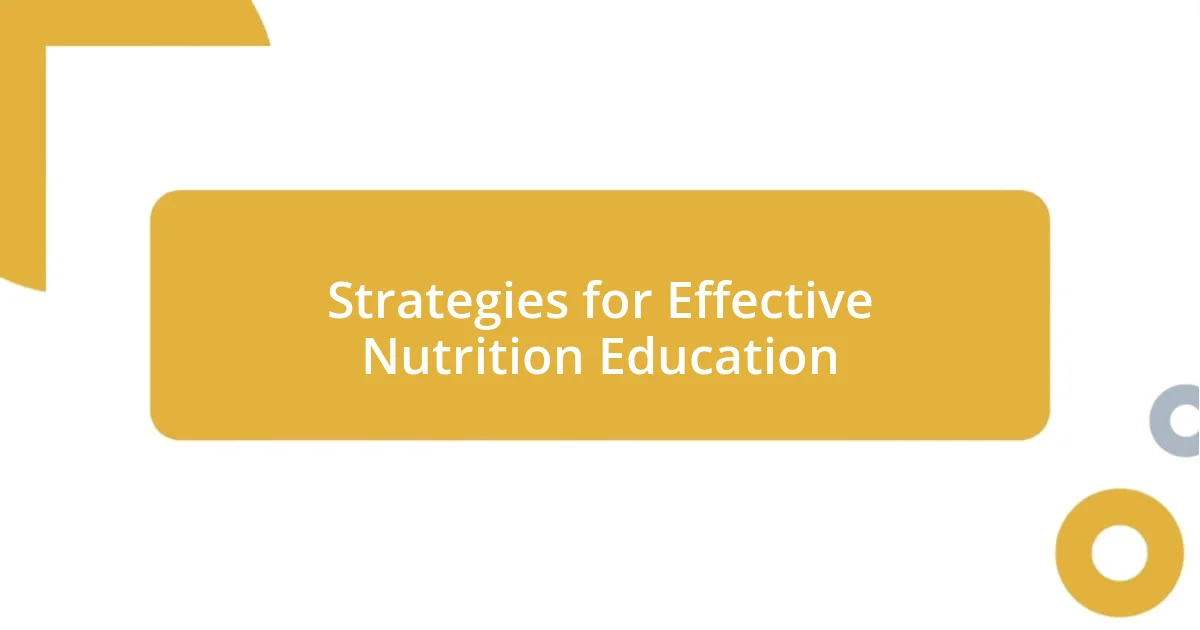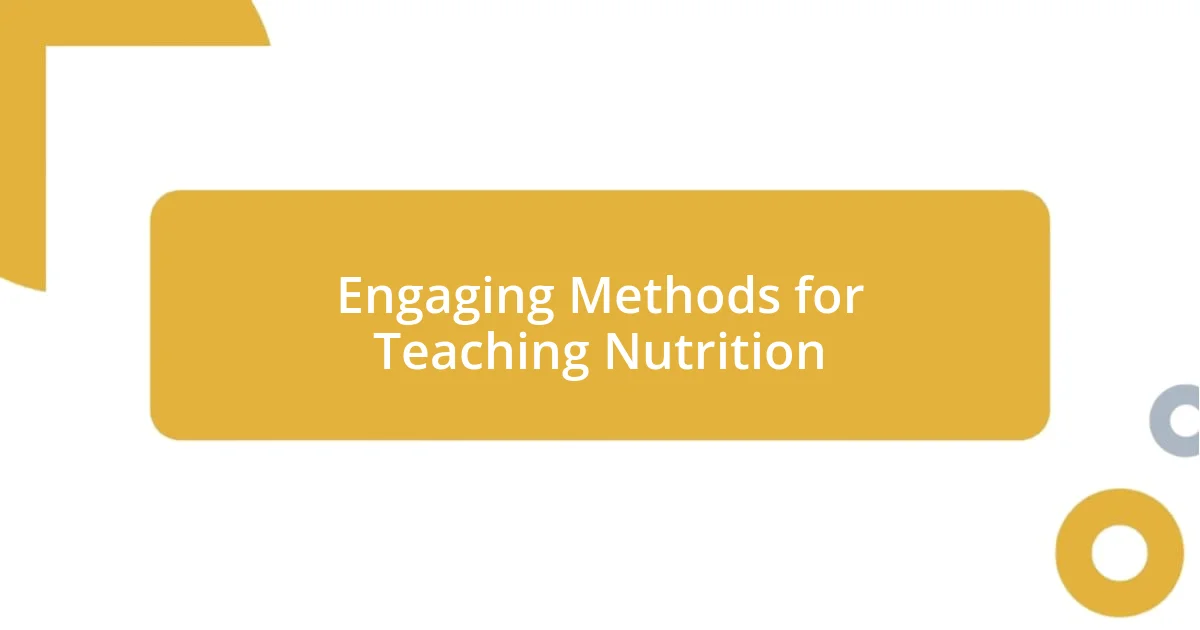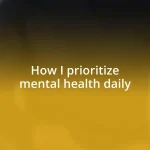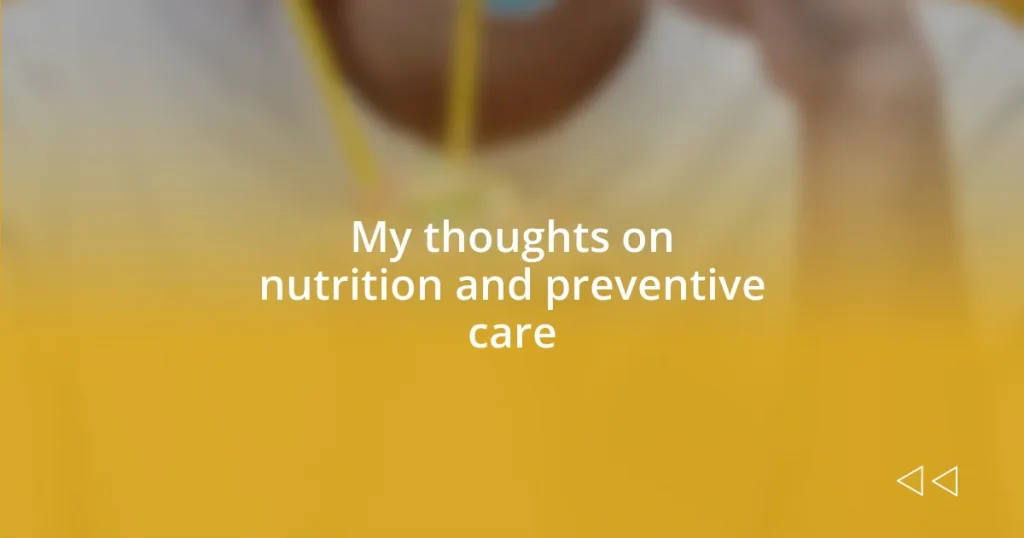Key takeaways:
- Nutrition education empowers individuals to make informed food choices, prevent chronic diseases, and enhance overall well-being.
- Key principles of healthy eating include balance, portion control, and mindfulness, which contribute to a more satisfying and healthier approach to meals.
- Overcoming common nutrition misconceptions, such as the stigma around fats and carbohydrates, is essential for promoting a healthier understanding of food and nutrition.

Understanding Nutrition Basics
Understanding the basics of nutrition is like learning the building blocks of a strong foundation for health. I often think back to when I first started my journey—I was overwhelmed by all the conflicting information out there. Have you ever felt that way? It can be frustrating to sift through diets and trends that seem to change overnight.
Carbohydrates, proteins, and fats are not just academic terms; they each play pivotal roles in how our bodies function day-to-day. When I began to understand that not all carbs are created equal, it was a revelation. Whole grains provide energy and fiber, while sugary snacks can lead to energy crashes. How do you feel after a high-sugar meal compared to one rich in whole grains and lean proteins?
Additionally, vitamins and minerals are essential nutrients that can’t be overlooked. I remember a time when I barely considered the impact of micronutrients on my wellbeing. But when I started adding more colorful fruits and veggies to my plate, I noticed an undeniable boost in my energy. How colorful is your plate? Eating a variety of foods can be enjoyable and beneficial, expanding your nutrient intake without any complicated formulas.

Importance of Nutrition Education
Nutrition education is essential in today’s fast-paced world where convenience often trumps health. I recall a time when I would quickly grab takeout, unaware of how those choices affected my body. This lack of knowledge can lead to poor eating habits, making it crucial to empower people with nutritional understanding.
Here are some key reasons why nutrition education is vital:
– Informed Choices: People equipped with nutrition knowledge can make better food decisions, impacting their long-term health.
– Chronic Disease Prevention: Understanding nutrition helps in preventing lifestyle diseases such as obesity, diabetes, and heart conditions.
– Mental Wellbeing: I noticed a shift in my mood and motivation when I prioritized nutrient-rich foods over processed options.
– Holistic Health Approach: Nutrition education promotes a comprehensive view of health, integrating physical, emotional, and mental well-being.
– Empowerment: It empowers individuals to take control of their health journey, fostering a sense of satisfaction and confidence in their food choices.
With awareness and education, I’ve seen how a simple shift in perspective about food can lead to transformative results in health and happiness. Wouldn’t it be liberating to learn how to nourish your body effectively?

Key Principles of Healthy Eating
Eating well isn’t just about choosing low-calorie options; it’s about understanding balance. I remember my early days of dieting when I thought cutting out whole food groups was the answer. But what I found is that a balanced plate of lean proteins, healthy fats, and colorful vegetables can lead to greater satisfaction and energy. It’s like painting a masterpiece where every color enhances the final work. When was the last time you truly enjoyed a meal that made you feel good inside?
Portion control plays a vital role too. It’s fascinating how serving sizes can shift our perception of what’s normal. There was a time I’d serve myself heaping plates, unaware that simply downscaling my portions made a world of difference. Have you tried using smaller plates? Your brain might just feel satisfied with less, leading to healthier overall eating habits.
One principle that often gets overlooked is the importance of mindfulness in eating. I’ll never forget when I first tried eating without distractions—no phone, no TV. It felt strange at first, but focusing on the flavors and textures made each bite more fulfilling. Mindful eating can promote better digestion and even enhance your relationship with food. Have you considered how being present at mealtime could transform your experience?
| Key Principle | Description |
|---|---|
| Balance | Incorporating a variety of nutrients on your plate for optimal health. |
| Portion Control | Understanding serving sizes to enjoy foods without overeating. |
| Mindfulness | Fully being present during meals to enhance enjoyment and digestion. |

Strategies for Effective Nutrition Education
When I think about effective nutrition education, I find that interactive learning techniques often resonate best with people. For instance, I once facilitated a workshop where participants brought in their favorite snacks. We analyzed the labels together, which sparked fascinating discussions about ingredients and their impacts on health. Doesn’t it feel empowering to learn about food choices directly from what we consume daily? Sharing these insights in a relatable context made it easier for everyone to grasp the concepts we discussed.
Another strategy I’ve integrated into my approach is storytelling. I vividly recall a session where I shared my own journey, which included struggles with emotional eating and discovering healthier outlets. By opening up about my experiences, I noticed participants felt more comfortable sharing their challenges as well. Isn’t it amazing how a simple story can create a sense of community and connection? When the atmosphere feels safe, individuals are much more likely to engage and apply what they’ve learned.
Lastly, I emphasize the role of visual aids, such as colorful charts or plates showcasing serving sizes. A while ago, I created a visual guide for meals that illustrated proper portions in a fun way. I was amazed by how much it shifted my friends’ perspectives on their dinner plates. How often do we overlook the power of visuals when making nutritional choices? Getting people to see food in a new light can promote healthier habits more effectively than just talking about them.

Engaging Methods for Teaching Nutrition
One engaging method I’ve found incredibly effective for teaching nutrition is hands-on cooking classes. I remember the first time I hosted one; we prepared a meal together, and participants were surprised to see how simple ingredients could come together to create something delicious and nutritious. As we chopped, stirred, and tasted, I watched the transformation from uncertainty to excitement. Have you ever felt the joy of creating a healthy meal from scratch? It’s not just about learning; it becomes an experience that changes their perspective on food.
Incorporating games and challenges can also spark interest and boost engagement in nutrition education. During a recent workshop, I introduced a “healthy swap” challenge where participants had to come up with healthier alternatives to their favorite snacks. It turned into a fun competition filled with laughter and creativity, with everyone eager to share their ideas. I still smile thinking about the bright energy in the room. Isn’t it refreshing when learning feels like play instead of a lecture? This approach fosters teamwork and collaboration, encouraging participants to learn from one another.
Another effective method I’ve embraced is the use of food demonstrations. I vividly recall a time when I showcased how to make a nutrient-dense smoothie live on social media. The responses were overwhelming—people shared their favorite ingredients and asked questions in real time. It’s fascinating how technology can bridge the gap between learning and interaction, creating a community where everyone feels involved. Have you considered how a simple demonstration can turn abstract concepts into tangible experiences? By making nutrition more accessible and relatable, I’ve seen participants not only learn but also embrace healthier choices in their everyday lives.

Overcoming Common Nutrition Misconceptions
It’s fascinating how many myths surround nutrition, especially regarding fats. I remember when I first started my journey into nutrition education; I was shocked to find out that not all fats are created equal. For years, I believed that avoiding fats was the key to good health, only to learn later about the benefits of healthy fats found in avocados and nuts. How often do we cling to outdated beliefs without questioning their validity? It’s incredibly liberating to shift our focus to understanding quality over quantity.
Another common misconception involves carbohydrates, particularly the fear surrounding gluten. Early in my nutrition journey, I encountered numerous individuals convinced that cutting out gluten entirely would solve all their health woes. After a little research and discussion, it became clear that many could enjoy gluten-rich foods without any adverse effects—especially if they focused on whole grains. Have you ever wondered if what we’ve been told about gluten is a bit exaggerated? I find it essential to encourage balanced views on carbohydrates, emphasizing their vital role in our diets.
Lastly, the idea that “all calories are created equal” often leads to confusion. I remember a conversation with a friend who thought that as long as she kept her calorie intake low, she would be healthy. It was a revelation when we discussed how nutrient-dense foods could provide far more benefits than empty-calorie snacks. Isn’t it true that the quality of our food plays a pivotal role in how we feel? It’s crucial to promote an understanding that not all calories provide the same value, and making informed choices is what truly nourishes our bodies.

Evaluating Nutrition Education Outcomes
Evaluating the outcomes of nutrition education can be incredibly revealing. I recall a workshop I led last year, where we assessed participants’ knowledge before and after our sessions. The growth in understanding was palpable; many participants were astonished to see how their perceptions had shifted. Have you ever experienced that moment when the light bulb goes on? It’s a powerful indication that education is effective.
To truly gauge these outcomes, I often use feedback forms, which provide insight into the participants’ feelings and behaviors post-education. For example, during a recent initiative, a participant shared that they started meal prepping after our class. Seeing someone take actionable steps toward healthier eating habits makes the effort worthwhile. Isn’t it fulfilling to witness that transformation firsthand?
Additionally, measuring long-term changes can provide deeper insights into the effectiveness of nutrition education. I’ve kept in contact with many former participants to understand how their food choices evolved over time. One individual even admitted to experimenting with plant-based meals regularly. These are the stories that inspire me to keep pushing forward. Don’t you think that the real goal of nutrition education is to create lasting change in people’s lives?















